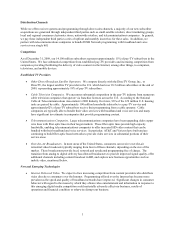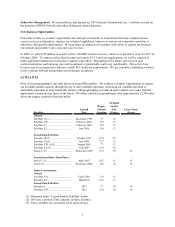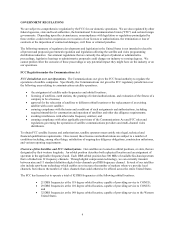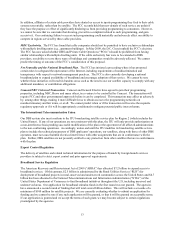Dish Network 2009 Annual Report Download - page 13
Download and view the complete annual report
Please find page 13 of the 2009 Dish Network annual report below. You can navigate through the pages in the report by either clicking on the pages listed below, or by using the keyword search tool below to find specific information within the annual report. 3
Distribution Channels
While we offer receiver systems and programming through direct sales channels, a majority of our new subscriber
acquisitions are generated through independent third parties such as small satellite retailers, direct marketing groups,
local and regional consumer electronics stores, nationwide retailers, and telecommunications companies. In general,
we pay these independent third parties a mix of upfront and monthly incentives for these sales. In addition, we
partner with telecommunications companies to bundle DISH Network programming with broadband and voice
services on a single bill.
Competition
As of December 31, 2009, our 14.100 million subscribers represent approximately 15% of pay-TV subscribers in the
United States. We face substantial competition from established pay-TV providers and increasing competition from
companies providing/facilitating the delivery of video content via the Internet, among other things, to computers,
televisions, and mobile devices.
Established TV Providers
x Other Direct Broadcast Satellite Operators. We compete directly with the DirecTV Group, Inc., or
DirecTV, the largest satellite TV provider in the U.S. which had over 18.5 million subscribers at the end of
2009, representing approximately 19% of pay-TV subscribers.
x Cable Television Companies. We encounter substantial competition in the pay-TV industry from numerous
cable television companies that operate via franchise licenses across the U.S. According to the National
Cable & Telecommunications Association’s 2008 Industry Overview, 96% of the 129 million U.S. housing
units are passed by cable. Approximately 100 million households subscribe to a pay-TV service and
approximately62% of pay-TV subscribers receive their programming from a cable operator. Cable
companies are typically able to bundle their video services with broadband and voice services and many
have significant investments in companies that provide programming content.
x Telecommunications Companies. Large telecommunications companies have been upgrading older copper
wire lines with fiber optic lines in their larger markets. These fiber optic lines provide high capacity
bandwidth, enabling telecommunications companies to offer increased HD video content that can be
bundled with their broadband and voice services. In particular, AT&T and Verizon have built and are
continuing to build fiber-optic based networks to provide video services in substantial portions of their
service areas.
x Over-the-Air Broadcasters. In most areas of the United States, consumers can receive over-the-air
terrestrial video broadcasts typically ranging from four to fifteen channels, depending on the size of the
market. These broadcasters provide local, network and syndicated programming free of charge. The
transition from analog to digital delivery has allowed broadcasters to provide improved signal quality, offer
additional channels including content broadcast in HD, and explore new business opportunities such as
mobile video, mentioned below.
New and Emerging Technologies
x Internet Delivered Video. We expect to face increasing competition from content providers who distribute
video directly to consumers over the Internet. Programming offered over the Internet has become more
prevalent as the speed and quality of broadband networks have improved. Significant changes in consumer
behavior with regard to the means by which they obtain video entertainment and information in response to
this emerging digital media competition could materially adversely affect our business, results of
operations and financial condition or otherwise disrupt our business.
























